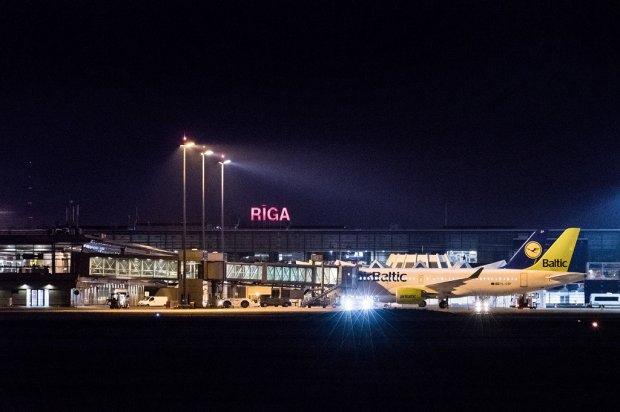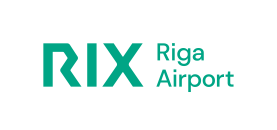Līce: Riga Airport is Experiencing the Fastest Development in Its History

“In order for Riga Airport to achieve its goal of becoming a modern and convenient North European air traffic hub and serving at least ten million passengers a year by 2023, the company's main task for the next five years is to implement the planned passenger and cargo infrastructure projects,” says Ilona Līce, Chairperson of the Board of Riga Airport.
Riga Airport wound up the year 2018 with a significant increase in all its key performance indicators: operational data on the operating results of 2018 show that last year the Airport served 7.06 million passengers - almost 16% more than a year before. The volume of cargo increased by 10.4%, exceeding 27 thousand tons, while the volume of flights increased by 11.5% with Riga Airport handling 83.5 thousand aircraft in 2018.
According to Līce, this increase significantly exceeds the average indicators of European airports - the data of Airport Council International (ACI) show that in the 3rd quarter of 2018 the average number of passengers in Europe increased by only 5%. The rapid increase in its passenger figures last year allowed Riga Airport to repeatedly enter the TOP 5 of fastest growing European airports handling 5-10 million passengers annually. “According to the latest ACI data, Riga Airport was the third fastest growing airport in its group also in the third quarter of last year, only lagging behind Spain's sixth busiest domestic airport in Seville and Sicily's second largest airport Palermo. In turn, in a study recently published by the international aviation data analysis company “VariFlight”, Riga Airport was recognised as the seventh most punctual airport in Europe in 2018,” notes Līce.
“This outcome is the result of purposeful work and long-term strategy. Previous years, we developed aerodrome and infrastructure related to passenger aircraft service, but from this year on we will focus on the expansion of passenger service infrastructure and development of cargo sector. In today's global world, well-developed infrastructure and low costs are the main weapons of competition among airports,” says Līce.
In 2019, the Airport will begin the implementation of terminal expansion stage 6, under which a new public terminal and the related infrastructure will be constructed. The new terminal will have both a modern and spacious passenger check-in area, a security control area and baggage reclaim and sorting facilities, as well as restaurants, cafés and shops. This will solve passenger service capacity issues that are currently being dealt with by introducing temporary improvements in the public part of the old terminal built in 1974, for example by extending the existing baggage belts, accommodating additional baggage sorting facilities, expanding the waiting area before security controls and increasing the number of check-in desks.
“The new Airport terminal will be connected to the “Rail Baltica” railway station, creating a unified passenger service complex and providing passengers with a convenient and fast connection not only to the capital of Latvia, but also to the entire “Rail Baltica” railway network covering the Baltic States, Poland and Finland,” says Līce.
Together with the stage 6 construction, the Airport is also planning an extensive development of its cargo-handling infrastructure. Already in 2019, the construction of a new cargo platform with an underground refuelling system will start; it will allow more large-fuselage aircraft to be served at the Airport and will relieve pressure on the current apron aircraft stands. In cooperation with investors, it is planned to develop a modern cargo logistics centre with an area of over 10 000 square metres. “Even though Riga Airport is already serving half of all Baltic aircraft, the cargo sector has great potential for development. The Airport's experience of handling Chinese e-commerce cargo last year demonstrates our ability to compete in this area,” says the Airport's manager.
At the same time, the Airport is also working on other infrastructure and technology development projects. Within the framework of the Cohesion Fund project “Development of Secure and Environmentally Friendly Infrastructure at Riga International Airport”, it is planned to modernise and expand the taxiing routes, to rebuild the access roads to the public part of the aerodrome, to reconstruct the technical service building, as well as to upgrade the rainwater sewerage system and lighting infrastructure.
Riga Airport was one of the first airports in Europe to launch (with the support of the Cohesion Fund) the implementation of the innovative “follow the green” aircraft guidance and control system. As part of the project, the taxiing routes were equipped with special centreline lights, which allow aircraft to taxi faster and safer under limited visibility conditions.
Līce emphasises that the decision made by the Cabinet of Ministers last year to allow the company to divert its profit for its development is of key importance for the implementation of the Airport’s development plans. 23% of the profit of 2017 will be paid out in dividends, but 77% will be redirected for development; in the next four years, 80% of the profit will be channelled to Airport’s development projects. All Airport development projects will be financed from the company's own resources without state budget support. The total planned medium-term investment is EUR 139 million.
The Airport continues to expand and improve the services available to passengers through the implementation of ambitious development projects. Last year, #investEU information stand - an educationally entertaining children's playground - was opened in the Airport's new North Pier; it is also worth mentioning that last autumn the Airport significantly increased the number of free baby carriages available at the Airport. For the convenience of passengers, Samsung work and rest area with 50 mobile charging stations was opened in the North Pier at the end of 2018. This year, it is planned to build a moving walkway in the gallery connecting terminals B and C, as well as to continue cooperation with the State Border Guard in order to speed up and make the border control process more convenient for passengers. It is planned to continue the expansion of car parks in 2019 by increasing the capacity of the long-term car park P3 with 640 parking spaces. Since last year, passengers can easily get to the terminal from both long-term car parks with a free Airport shuttle service.
Riga Airport is not only an important object of transport infrastructure, but it also facilitates the national economy and re-emigration of Latvian nationals. Last year, the Airport launched a wide-ranging recruitment campaign aimed at both - those living abroad and job seekers from Latvia. For this purpose, a special Airport job vacancy portal www.darbslidosta.lv has been created, where current job offers are updated daily and anyone interested can apply on-line for the vacant positions. Last year, Riga Airport was recognised as the fairest payer in Latvia in the Latvian labour market survey conducted by “Fontes” human resources management consultancy and research company.
The Airport pays great attention to environmental issues. In 2018, a new action plan for reducing aircraft noise in nearby areas was developed in cooperation with local authorities, state institutions and other stakeholders. Last year, the Airport started environmental monitoring in forests in the Airport vicinity and launched assessment of the impact of its activity on nearby forests.
More information to media:
Laura Karnīte
Head of the Communication Unit
SJSC Riga International Airport
l.karnite@riga-airport.com
GSM: +371 29165007
T: +371 67207694
www.riga-airport.com


